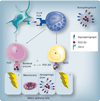Autoimmune disease triggered by infection with alphaproteobacteria
- PMID: 20161124
- PMCID: PMC2742979
- DOI: 10.1586/ECI.09.23
Autoimmune disease triggered by infection with alphaproteobacteria
Abstract
Despite having long been postulated, compelling evidence for the theory that microbial triggers drive autoimmunity has only recently been reported. A specific association between Novosphingobium aromaticivorans, an ubiquitous alphaproteobacterium, and primary biliary cirrhosis (PBC) has been uncovered in patients with PBC. Notably, the association between Novosphingobium infection and PBC has been confirmed in a mouse model in which infection leads to the development of liver lesions resembling PBC concomitant with the production of anti-PDC-E2 antibodies that cross-react with conserved PDC-E2 epitopes shared by Novosphingobium. The discovery of infectious triggers of autoimmunity is likely to change our current concepts about the etiology of various autoimmune syndromes and may suggest new and simpler ways to diagnose and treat these debilitating diseases.
Figures


Similar articles
-
Novosphingobium aromaticivorans: a potential initiator of primary biliary cirrhosis.Am J Gastroenterol. 2004 Nov;99(11):2147-9. doi: 10.1111/j.1572-0241.2004.41121.x. Am J Gastroenterol. 2004. PMID: 15554995
-
Patients with primary biliary cirrhosis react against a ubiquitous xenobiotic-metabolizing bacterium.Hepatology. 2003 Nov;38(5):1250-7. doi: 10.1053/jhep.2003.50446. Hepatology. 2003. PMID: 14578864
-
Pathogen infections and primary biliary cholangitis.Clin Exp Immunol. 2019 Jan;195(1):25-34. doi: 10.1111/cei.13198. Epub 2018 Sep 17. Clin Exp Immunol. 2019. PMID: 30099750 Free PMC article. Review.
-
Environmental basis of primary biliary cholangitis.Exp Biol Med (Maywood). 2018 Jan;243(2):184-189. doi: 10.1177/1535370217748893. Epub 2018 Jan 7. Exp Biol Med (Maywood). 2018. PMID: 29307284 Free PMC article. Review.
-
Liver autoimmunity triggered by microbial activation of natural killer T cells.Cell Host Microbe. 2008 May 15;3(5):304-15. doi: 10.1016/j.chom.2008.03.009. Cell Host Microbe. 2008. PMID: 18474357 Free PMC article.
Cited by
-
Ileal mucosa-associated microbiota overgrowth associated with pathogenesis of primary biliary cholangitis.Sci Rep. 2021 Oct 5;11(1):19705. doi: 10.1038/s41598-021-99314-9. Sci Rep. 2021. PMID: 34611265 Free PMC article.
-
Distinct roles of Cdc42 in thymopoiesis and effector and memory T cell differentiation.PLoS One. 2011 Mar 24;6(3):e18002. doi: 10.1371/journal.pone.0018002. PLoS One. 2011. PMID: 21455314 Free PMC article.
-
MSCs Therapy Reverse the Gut Microbiota in Hypoxia-Induced Pulmonary Hypertension Mice.Front Physiol. 2021 Aug 31;12:712139. doi: 10.3389/fphys.2021.712139. eCollection 2021. Front Physiol. 2021. PMID: 34531759 Free PMC article.
-
NKT Cells Contribute to the Control of Microbial Infections.Front Cell Infect Microbiol. 2021 Sep 14;11:718350. doi: 10.3389/fcimb.2021.718350. eCollection 2021. Front Cell Infect Microbiol. 2021. PMID: 34595131 Free PMC article. Review.
-
Innate and cytokine-driven signals, rather than microbial antigens, dominate in natural killer T cell activation during microbial infection.J Exp Med. 2011 Jun 6;208(6):1163-77. doi: 10.1084/jem.20102555. Epub 2011 May 9. J Exp Med. 2011. PMID: 21555485 Free PMC article.
References
-
- Rioux JD, Abbas AK. Paths to understanding the genetic basis of autoimmune disease. Nature. 2005;435(7042):584–589. - PubMed
-
- Bjorses P, Aaltonen J, Horelli-Kuitunen N, Yaspo ML, Peltonen L. Gene defect behind APECED: a new clue to autoimmunity. Hum. Mol. Genet. 1998;7(10):1547–1553. - PubMed
-
- Walker LS, Abbas AK. The enemy within: keeping self-reactive T cells at bay in the periphery. Nat. Rev. Immunol. 2002;2(1):11–19. - PubMed
-
- Pisetsky DS. The role of innate immunity in the induction of autoimmunity. Autoimmun. Rev. 2008;8(1):69–72. - PubMed
-
- Bergman M, Del Prete G, van Kooyk Y, Appelmelk B. Helicobacter pylori phase variation, immune modulation and gastric autoimmunity. Nat. Rev. Microbiol. 2006;4(2):151–159. - PubMed
Website
-
- Proteobacteria classification. Systema Naturae. 2000. [Accessed 20 April 2009]. www.taxonomy.nl/main/classification/1002851.htm.
Grants and funding
LinkOut - more resources
Full Text Sources
